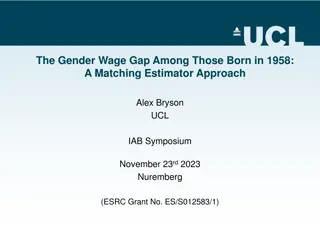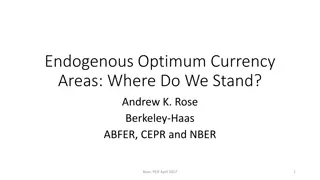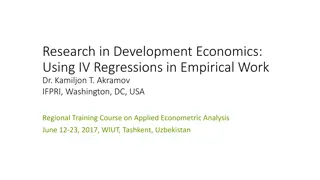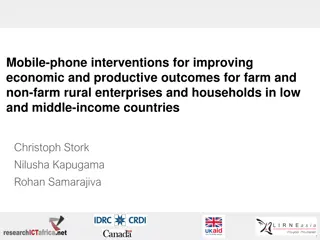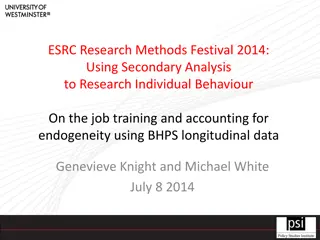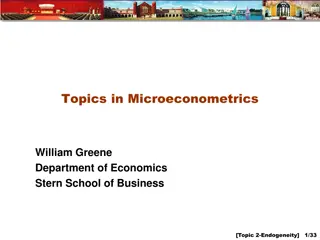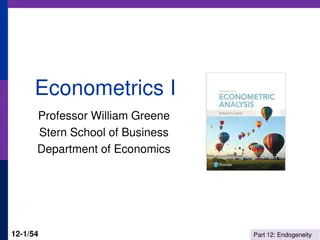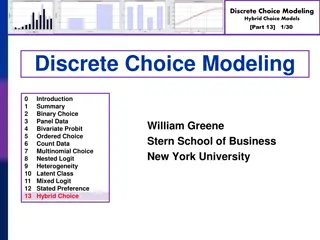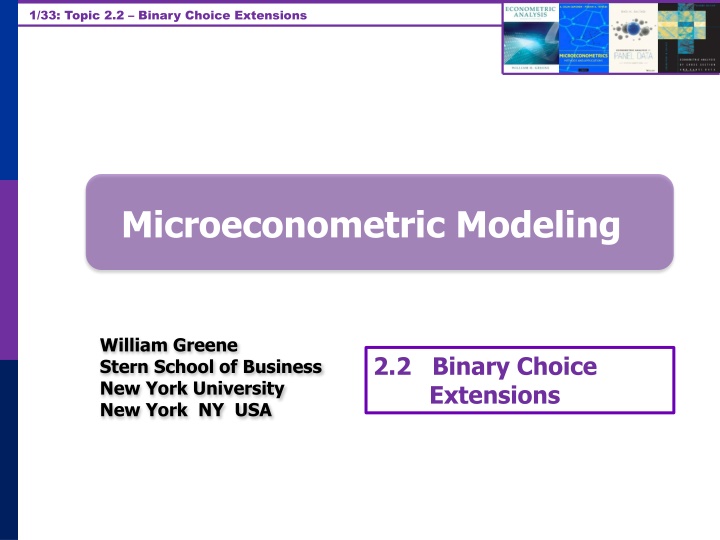
Microeconometric Modeling and Binary Choice Extensions
Explore the concepts, models, and inference methods in microeconometric modeling with a focus on binary choice extensions. Topics include partial effects, application of the delta method, computing effects at data means, APE versus partial effects, and estimation methods by Maximum Likelihood. Learn about Average Partial Effect, Krinsky and Robb's approach, and more.
Download Presentation

Please find below an Image/Link to download the presentation.
The content on the website is provided AS IS for your information and personal use only. It may not be sold, licensed, or shared on other websites without obtaining consent from the author. If you encounter any issues during the download, it is possible that the publisher has removed the file from their server.
You are allowed to download the files provided on this website for personal or commercial use, subject to the condition that they are used lawfully. All files are the property of their respective owners.
The content on the website is provided AS IS for your information and personal use only. It may not be sold, licensed, or shared on other websites without obtaining consent from the author.
E N D
Presentation Transcript
1/33: Topic 2.2 Binary Choice Extensions Microeconometric Modeling William Greene Stern School of Business New York University New York NY USA 2.2 Binary Choice Extensions
2/33: Topic 2.2 Binary Choice Extensions Concepts Models Mundlak Approach Nonlinear Least Squares Quasi Maximum Likelihood Delta Method Average Partial Effect Krinsky and Robb Method Interaction Term Endogenous RHS Variable Control Function FIML 2 Step ML Scaled Coefficient Direct and Indirect Effect GHK Simulator Fractional Response Model Probit Logit Multivariate Probit
3/33: Topic 2.2 Binary Choice Extensions Inference About Partial Effects
4/33: Topic 2.2 Binary Choice Extensions Partial Effects for Binary Choice ( : [ | ] exp [ | ] y = x ) ( ) ( ( ) / 1 exp + = = LOGIT x x x x y ( ) ) x = = x x 1 ( ) [ | ] y = PROBIT x x ( ) [ | ] y x x = = = x x ( ) = = EXTREME VALUE x [ | ] y P exp exp 1 [ | ] y x = = = P logP x 1 1
5/33: Topic 2.2 Binary Choice Extensions The Delta Method ( , ) , x f ( ) ( ( ) ) = = = x , G x , V = , Est.Asy.Var f ) ( ) = Probit G x I x x ( ( ) ) ( ) ( ) ( 1 2 ) = + Logit G x x I x x 1 ( ) ( 1 , P = 1 l + ExtVlu G x x I x x P , logP ) , ( og 1 1 = G x V G x Est.Asy.Var , ,
6/33: Topic 2.2 Binary Choice Extensions Computing Effects Compute at the data means? Simple Inference is well defined Average the individual effects More appropriate? Asymptotic standard errors more complicated. Is testing about marginal effects meaningful? f(b x) must be > 0; b is highly significant How could f(b x)*b equal zero?
7/33: Topic 2.2 Binary Choice Extensions APE vs. Partial Effects at the Mean Delta Method for Average Partial Effect 1 Estimator of Var N N = G Var G PartialEffect i = 1 i
8/33: Topic 2.2 Binary Choice Extensions Method of Krinsky and Robb Estimate by Maximum Likelihood with b Estimate asymptotic covariance matrix with V Draw R observations b(r) from the normal population N[b,V] b(r) = b + C*v(r), v(r) drawn from N[0,I] C = Cholesky matrix, V = CC Compute partial effects d(r) using b(r) Compute the sample variance of d(r),r=1, ,R Use the sample standard deviations of the R observations to estimate the sampling standard errors for the partial effects.
9/33: Topic 2.2 Binary Choice Extensions Krinsky and Robb Delta Method
10/33: Topic 2.2 Binary Choice Extensions Partial Effect for Nonlinear Terms = + + + + 2 Prob Prob Age (1) Must be computed for a specific value of Age (2) Compute standard errors using delta method or Krins (3) Compute confidence intervals for different values of Age. (4) Test of hypothesis that this equals zero is identical to a test that ( +2 Age) = 0. Is this an interesting hypothesis? [ Age Age Income Female] 1 2 3 4 = + + + + + 2 [ Age Age Income Female] ( 2 Age) 1 2 3 4 1 2 ky and Robb. 1 2 + + + 2 (1.30811 .06487 [( .06487 .0091 ] .17362 .39666) ) Age Age Age Income Female Prob AGE = 2(.0091)
11/33: Topic 2.2 Binary Choice Extensions Average Partial Effect: Averaged over Sample Incomes and Genders for Specific Values of Age
12/33: Topic 2.2 Binary Choice Extensions Endogeneity
13/33: Topic 2.2 Binary Choice Extensions Endogenous RHS Variable U* = x + h + y = 1[U* > 0] E[ |h] 0 (h is endogenous) Case 1: h is binary = a treatment effect Case 2: h is continuous Approaches Parametric: Maximum Likelihood Semiparametric (not developed here): GMM Various approaches for case 2 2 Stage least squares a good approximation?
14/33: Topic 2.2 Binary Choice Extensions Endogenous Binary Variable U* = x + h + y = 1[U* > 0] h* = z + u h = 1[h* > 0] E[ |h*] 0 Cov[u, ] 0 Additional Assumptions: (u, ) ~ N[(0,0),( u2, u, 1)] z = a valid set of exogenous variables, uncorrelated with (u, ) Correlation = . This is the source of the endogeneity This is not IV estimation. Z may be uncorrelated with X without problems.
15/33: Topic 2.2 Binary Choice Extensions Endogenous Binary Variable P(Y = y,H = h) = P(Y = y|H =h) x P(H=h) This is a simple bivariate probit model. Not a simultaneous equations model - the estimator is FIML, not any kind of least squares. Doctor = F(age,age2,income,female,Public) Public = F(age,educ,income,married,kids,female)
16/33: Topic 2.2 Binary Choice Extensions Log Likelihood for the RBP Model = = + = = z x * * , h + + 1( * 1( * y 0) 0) h y u h y h , 0 0 1 ~ , N z 2 1 u = + + x log ln ( , , ) L 2 i i = = | 1, 1 i y h + z x ln ( , , ) 2 i i = = | 1, 0 i y h + z x ln ( , , ) 2 i i = = | 0, 1 i y h , ) + z x ln ( , 2 i i = = | 0, 0 i y h
17/33: Topic 2.2 Binary Choice Extensions FIML Estimates ----------------------------------------------------------------------------- FIML - Recursive Bivariate Probit Model Dependent variable PUBDOC Log likelihood function -25671.32339 Estimation based on N = 27326, K = 14 Inf.Cr.AIC = 51370.6 AIC/N = 1.880 --------+-------------------------------------------------------------------- PUBLIC| Standard Prob. 95% Confidence DOCTOR| Coefficient Error z |z|>Z* Interval --------+-------------------------------------------------------------------- |Index equation for PUBLIC........................................ Constant| 3.55056*** .07446 47.68 .0000 3.40462 3.69650 AGE| .00067 .00115 .58 .5626 -.00159 .00293 EDUC| -.16835*** .00416 -40.48 .0000 -.17650 -.16020 INCOME| -.98735*** .05172 -19.09 .0000 -1.08872 -.88598 MARRIED| -.00997 .02922 -.34 .7329 -.06724 .04729 HHKIDS| -.08094*** .02510 -3.22 .0013 -.13014 -.03174 FEMALE| .12140*** .02231 5.44 .0000 .07768 .16512 |Index equation for DOCTOR........................................ Constant| .58983*** .14474 4.08 .0000 .30615 .87351 AGE| -.05740*** .00601 -9.56 .0000 -.06917 -.04563 AGESQ| .00082*** .6817D-04 12.10 .0000 .00069 .00096 INCOME| .08900* .05097 1.75 .0808 -.01091 .18890 FEMALE| .34580*** .01629 21.22 .0000 .31386 .37773 PUBLIC| .43595*** .07358 5.92 .0000 .29174 .58016 |Disturbance correlation............................................. RHO(1,2)| -.17317*** .04075 -4.25 .0000 -.25303 -.09330 --------+--------------------------------------------------------------------
18/33: Topic 2.2 Binary Choice Extensions Partial Effects Conditional Mean x x z = = = ( + x x E[ | , ] E[ | , ] Partial Effects Direct Ef E[ | , ] ) y y h h h [ | , ] Prob( ( = E E y h = = z + = = z x 1| )E[ | , z x 0| )E[ | , ) ( x 0] Prob( ) ( 1] h y h h y h + + z x ) ( ) fects x z x y = ) ( + ) ( + z x z x ( ) ( ) Indirect Effects E[ | , ] y z x z = ) ( + ) ( + z x z x ( ) ( ) = + z x x ( ) ( ) ( )
19/33: Topic 2.2 Binary Choice Extensions FIML Partial Effects Two Stage Least Squares Effects
20/33: Topic 2.2 Binary Choice Extensions Identification Issues Exclusions are not needed for estimation Identification is, in principle, by functional form Researchers usually have a variable in the treatment equation that is not in the main probit equation to improve identification A fully simultaneous model y1 = f(x1,y2), y2 = f(x2,y1) Not identified even with exclusion restrictions (Model is incoherent )
21/33: Topic 2.2 Binary Choice Extensions A Simultaneous Equations Model Simultaneous Equations Model y * = + y + , y =1(y * > 0) y * = + y + ,y =1(y * > 0) x 2 x 1 1 1 2 1 1 1 1 2 2 2 1 2 2 2 0 1 T (Not estimable. The compu compute 'estimates' but they have no meaning.) 0 1 ~N , 1 2 his model is not identified. Incoh ter c e ren t . an
22/33: Topic 2.2 Binary Choice Extensions Fully Simultaneous Model ---------------------------------------------------------------------- FIML Estimates of Bivariate Probit Model Dependent variable DOCHOS Log likelihood function -20318.69455 --------+------------------------------------------------------------- Variable| Coefficient Standard Error b/St.Er. P[|Z|>z] Mean of X --------+------------------------------------------------------------- |Index equation for DOCTOR Constant| -.46741*** .06726 -6.949 .0000 AGE| .01124*** .00084 13.353 .0000 43.5257 FEMALE| .27070*** .01961 13.807 .0000 .47877 EDUC| -.00025 .00376 -.067 .9463 11.3206 MARRIED| -.00212 .02114 -.100 .9201 .75862 WORKING| -.00362 .02212 -.164 .8701 .67705 HOSPITAL| 2.04295*** .30031 6.803 .0000 .08765 |Index equation for HOSPITAL Constant| -1.58437*** .08367 -18.936 .0000 AGE| -.01115*** .00165 -6.755 .0000 43.5257 FEMALE| -.26881*** .03966 -6.778 .0000 .47877 HHNINC| .00421 .08006 .053 .9581 .35208 HHKIDS| -.00050 .03559 -.014 .9888 .40273 DOCTOR| 2.04479*** .09133 22.389 .0000 .62911 |Disturbance correlation RHO(1,2)| -.99996*** .00048 ******** .0000 --------+-------------------------------------------------------------
23/33: Topic 2.2 Binary Choice Extensions A Recursive Bivariate Probit Model Treatment Effects Recursive Simultaneous Equations Model x y * = y * = + , y =1(y *>0) + y + ,y =1(y *>0) z 1 1 1 1 2 1 2 2 2 0 1 0 1 ~N , 1 2 This model is identified. It can be consistent estimated by full information maximum likelihood. Treated as a bivariate probit model. The simultaneity is accounted for by the log likelihood formulation. ly and efficiently
24/33: Topic 2.2 Binary Choice Extensions ----------------------------------------------------------------------------- FIML - Recursive Bivariate Probit Model Dependent variable PUBDOC Log likelihood function -25671.32339 Estimation based on N = 27326, K = 14 Inf.Cr.AIC = 51370.6 AIC/N = 1.880 --------+-------------------------------------------------------------------- PUBLIC| Standard Prob. 95% Confidence DOCTOR| Coefficient Error z |z|>Z* Interval --------+-------------------------------------------------------------------- |Index equation for PUBLIC.................................... Constant| 3.55056*** .07446 47.68 .0000 3.40462 3.69650 AGE| .00067 .00115 .58 .5626 -.00159 .00293 EDUC| -.16835*** .00416 -40.48 .0000 -.17650 -.16020 INCOME| -.98735*** .05172 -19.09 .0000 -1.08872 -.88598 MARRIED| -.00997 .02922 -.34 .7329 -.06724 .04729 HHKIDS| -.08094*** .02510 -3.22 .0013 -.13014 -.03174 FEMALE| .12140*** .02231 5.44 .0000 .07768 .16512 |Index equation for DOCTOR.................................... Constant| .58983*** .14474 4.08 .0000 .30615 .87351 AGE| -.05740*** .00601 -9.56 .0000 -.06917 -.04563 AGESQ| .00082*** .6817D-04 12.10 .0000 .00069 .00096 INCOME| .08900* .05097 1.75 .0808 -.01091 .18890 FEMALE| .34580*** .01629 21.22 .0000 .31386 .37773 PUBLIC| .43595*** .07358 5.92 .0000 .29174 .58016 |Disturbance correlation......................................... RHO(1,2)| -.17317*** .04075 -4.25 .0000 -.25303 -.09330 --------+--------------------------------------------------------------------
25/33: Topic 2.2 Binary Choice Extensions Treatment Effects y1is a treatment Treatment effect of y1 on y2. Prob(y2=1)y1=1 Prob(y2=1)y1=0 = ( x + ) - ( x) Treatment effect on the treated involves an unobserved counterfactual. Compare being treated to being untreated for someone who was actually treated. Prob(y2=1|y1=1)y1=1 - Prob(y2=1|y1=1)y1=0
26/33: Topic 2.2 Binary Choice Extensions Treatment Effect on the Treated + z , ) x z x z ( , , ) ) ( , = 2 2 TET ( Average treatment effect on the treated estimated by + z , ) z x z x ( , , ) ( ) ( , = 2 2 i i i i TET 1 1 = y i
27/33: Topic 2.2 Binary Choice Extensions Treatment Effects --------------------------------------------------------------------- Partial Effects Analysis for RcrsvBvProb: ATE of PUBLIC on DOCTOR --------------------------------------------------------------------- Effects on function with respect to PUBLIC Results are computed by average over sample observations Partial effects for binary var PUBLIC computed by first difference --------------------------------------------------------------------- df/dPUBLIC Partial Standard (Delta Method) Effect Error |t| 95% Confidence Interval --------------------------------------------------------------------- APE. Function .16446 .02820 5.83 .10920 .21973 --------------------------------------------------------------------- Partial Effects Analysis for RcrsvBvProb: ATET of PUBLIC on DOCTOR --------------------------------------------------------------------- Effects on function with respect to PUBLIC Results are computed by average over sample observations Partial effects for binary var PUBLIC computed by first difference --------------------------------------------------------------------- df/dPUBLIC Partial Standard (Delta Method) Effect Error |t| 95% Confidence Interval --------------------------------------------------------------------- APE. Function .15417 .02482 6.21 .10553 .20282
30/33: Topic 2.2 Binary Choice Extensions Causal Inference 1 + + ( ) X PIP + PIP 1 ij PIP ij The authors used instead of ij 1 1 + + ( ) - ( ) X X 1 1 ij PIP ij It is not clear why they could not use the delta method for this.
33/33: Topic 2.2 Binary Choice Extensions Application: Gender Economics at Liberal Arts Colleges Journal of Economic Education, fall, 1998.
34/33: Topic 2.2 Binary Choice Extensions Estimated Recursive Model
35/33: Topic 2.2 Binary Choice Extensions Estimated Effects: Decomposition
36/33: Topic 2.2 Binary Choice Extensions A Sample Selection Model Sample Selection Model y * = + , y =1(y *>0) y * = + ,y =1(y *>0) x 2 x 1 1 1 1 1 1 2 2 2 2 2 0 1 y is only observed when y = 1. f(y ,y ) = Prob[y =1|y =1]*Prob[y =1] (y =1,y =1) 1 2 = Prob[y =0|y =1]*Prob[y =1] (y =0,y =1) = Prob[y =0] (y =0) 0 1 ~N , 1 2 1 2 1 2 1 2 2 1 2 2 1 2 2 2
37/33: Topic 2.2 Binary Choice Extensions Sample Selection Model: Estimation f(y ,y ) = Prob[y = 1|y =1]*Prob[y =1] (y =1,y =1) = Prob[y =0|y =1]*Prob[y =1] (y =0,y =1) = Prob[y =0] (y =0) Terms in the log likelih 2 2 i2 (y =0) (- ) (Univariate normal) Estimation is by full inf ormation maximum likelihood. There is no "lambda" variable. 1 2 1 2 2 1 2 1 2 2 1 2 2 2 ood: , , (y =1,y =1) ( (y =0,y =1) (- x x x x x , ) (Bivariate normal) ,- ) (Bivariate normal) 1 2 2 1 i1 2 i2 1 2 2 1 i1 2 i2
38/33: Topic 2.2 Binary Choice Extensions Application: Credit Scoring American Express: 1992 N = 13,444 Applications Observed application data Observed acceptance/rejection of application N1 = 10,499 Cardholders Observed demographics and economic data Observed default or not in first 12 months Full Sample is in AmEx.lpj; description shows when imported.
42/33: Topic 2.2 Binary Choice Extensions Endogenous Continuous Variable U* = x + h + y = 1[U* > 0] h = z + u E[ |h] 0 Cov[u, ] 0 Additional Assumptions: (u, ) ~ N[(0,0),( u2, u, 1)] z = a valid set of exogenous variables, uncorrelated with (u, ) Correlation = . This is the source of the endogeneity This is not IV estimation. Z may be uncorrelated with X without problems.
43/33: Topic 2.2 Binary Choice Extensions Endogenous Income Income responds to Age, Age2, Educ, Married, Kids, Gender 0 = Not Healthy 1 = Healthy Healthy = 0 or 1 Age, Married, Kids, Gender, Income Determinants of Income (observed and unobserved) also determine health satisfaction.
44/33: Topic 2.2 Binary Choice Extensions Estimation by ML (Control Function) x Probit fit of y to and will not consistently estimate ( , ) because of the correlation between h and induced by the correlation of u and . Using the bivariate normality, h + + x ( / ) h u = = u 1| , ) x Prob( y h 2 1 Insert = ( - u )/ and include f(h| ) to form logL h z z i i u - h z + + i i x h i i u + log (2 1) y i 2 1 N logL= i=1 - h 1 z i i log u u
45/33: Topic 2.2 Binary Choice Extensions Two Approaches to ML Full information ML. (1) with respect to ( , , (The built in Stata routine IVPROBIT does this. It is not an instrumental variable estimat Note also, this does not imply replacing h with a prediction Maximize the full log likelihood , , ) u or; it i s a FIML estimator.) from the regression then using probit with h instead of h. (2) Two step limited information ML. (Control Fun (a) Use OLS to estimate and (b) Compute = / = ( i i v u s + + ct i n) o a with and s. )/ i s a z u h i x v h = + + i i i x v (c) log log h i i i 2 1 x The second step is to fit a probit m solve back for ( , , ) from ( , , ) and from the previously estimated and s. Use the delta method to compute standard errors. a odel for y to ( , , ) then h v
46/33: Topic 2.2 Binary Choice Extensions FIML Estimates ---------------------------------------------------------------------- Probit with Endogenous RHS Variable Dependent variable HEALTHY Log likelihood function -6464.60772 --------+------------------------------------------------------------- Variable| Coefficient Standard Error b/St.Er. P[|Z|>z] Mean of X --------+------------------------------------------------------------- |Coefficients in Probit Equation for HEALTHY Constant| 1.21760*** .06359 19.149 .0000 AGE| -.02426*** .00081 -29.864 .0000 43.5257 MARRIED| -.02599 .02329 -1.116 .2644 .75862 HHKIDS| .06932*** .01890 3.668 .0002 .40273 FEMALE| -.14180*** .01583 -8.959 .0000 .47877 INCOME| .53778*** .14473 3.716 .0002 .35208 |Coefficients in Linear Regression for INCOME Constant| -.36099*** .01704 -21.180 .0000 AGE| .02159*** .00083 26.062 .0000 43.5257 AGESQ| -.00025*** .944134D-05 -26.569 .0000 2022.86 EDUC| .02064*** .00039 52.729 .0000 11.3206 MARRIED| .07783*** .00259 30.080 .0000 .75862 HHKIDS| -.03564*** .00232 -15.332 .0000 .40273 FEMALE| .00413** .00203 2.033 .0420 .47877 |Standard Deviation of Regression Disturbances Sigma(w)| .16445*** .00026 644.874 .0000 |Correlation Between Probit and Regression Disturbances Rho(e,w)| -.02630 .02499 -1.052 .2926 --------+-------------------------------------------------------------
47/33: Topic 2.2 Binary Choice Extensions Partial Effects: Scaled Coefficients Conditional Mean x z h , , = = u ( + + + x x E[ | E[y|x, , ] = [ z Partial Effects. Assume z x z x E[y| , ] = x The integral does not have a closed form, but it can easily be simulated: x z x For v k , . ariables only in x omit For variables only in z omit ] ) where ~ N[0,1] + z x (just for convenience) y h h v = + v z v v u ( )] u = E[y| , , ] x z v = + + + x z [ ( )]( ) v u E[y| , , ] x x z v = + + + )] ( ) x z E ( ) [ ( v v dv v u E[y| , ] 1 R R = + + + x z . ( ) [ ( )] Est u r v = 1 r , . k
48/33: Topic 2.2 Binary Choice Extensions Partial Effects = 0.53778 The scale factor is computed using the model coefficients, means of the variables and 35,000 draws from the standard normal population.
49/33: Topic 2.2 Binary Choice Extensions Two Stage Least Squares
50/33: Topic 2.2 Binary Choice Extensions Multivariate Binary Choice Models Bivariate Probit Models Analysis of bivariate choices Marginal effects Prediction No bivariate logit there is no reasonable bivariate counterpart Simultaneous Equations and Recursive Models A Sample Selection Bivariate Probit Model The Multivariate Probit Model Specification Simulation based estimation Inference Partial effects and analysis The panel probit model


